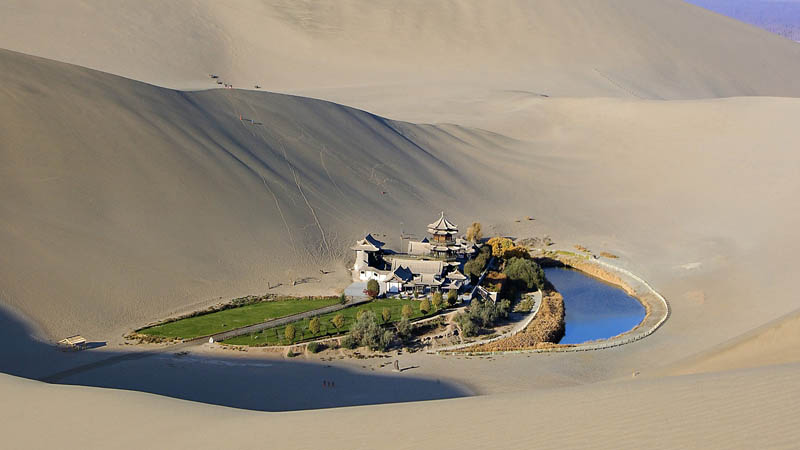

There's something deeply appealing about greenery amid the desert — and it seems even more precious when it's a worrisomely tiny patch.
Dunhuang is an old Silk Road city famous for the Mogao caves, which contain Buddhist paintings and manuscripts:A Crescent of Water Is Slowly Sinking Into the Desert
Jim Yardley New York Times
May 27, 2006
DUNHUANG, China, May 26 — At the bottom of the mountainous dunes once traversed by traders and pilgrims on the ancient Silk Road, Wang Qixiang stood with a camera draped around his neck. He was a modern-day pilgrim of sorts, a tourist.
He and his wife had traveled by train more than 2,000 miles from eastern China to the forbidding emptiness of the Gobi Desert to glimpse at a famous pool of water known as Crescent Lake. They came because the lake has been rapidly shrinking into the desert sand, and they feared it might soon disappear.
"It is a miracle of the desert," said Mr. Wang, 67.
In this desert oasis where East once met West and that is home to one of the world's greatest shrines to Buddhism, the water is disappearing. Crescent Lake has dropped more than 25 feet in the last three decades while the underground water table elsewhere in the area has fallen by as much as 35 feet.
An ancient city that once served as China's gateway to the West, Dunhuang is now threatened by very modern demands. A dam built three decades ago to help local farming, combined with a doubling of the population, have overstressed a fragile desert hydrology that had been stable for thousands of years.
"I would call it an ecological crisis," said Zhang Mingquan, a professor at Lanzhou University who specializes in the region's hydrology. "The problem is the human impact. People are overusing the amount of water that the area can sustain."
Heaped up in layers, but without any order, there appeared in the dim light of the priest's little lamp a solid mass of manuscript bundles rising to a height of nearly ten feet, and filling, as subsequent measurement showed, close on 500 cubic feet. The area left clear within the room was just sufficient for two people to stand in - Aurel Stein, Ruins of Desert Cathay, Volume II
Erebus was the primordial Greek god of darkness: son of Chaos, husband of Nyx, the goddess of night, and father of Aether, Hypnos, and Thanatos. Here is his namesake, Mount Erebus, glowing in the dark Antarctic winter. This volcano has been active at least since 1972, and contains one of the five longest-lived lava lakes on Earth.
Here's an abandoned Prada store near the small town of Valentine, Texas:
Actually it's a modern art installation, but I thought it was better to announce it as you're supposed to see it: a Prada store mysteriously sitting in the middle of nowhere, 1.4 miles northwest of Valentine, Texas.
It's called Prada Marfa. Conceived by the art team Elmgreen and Dragset and realized with the help of architects Ronald Rael and Virginia San Fratello, it cost $80,000 and was intended to never be repaired, so it would slowly fall apart and decay. But they changed their minds when, three days after the sculpture was completed, vandals broke in and stole handbags and shoes. Now it has security cameras!
This photo was taken by Mina Bozovic.
Verily at the first Chaos came to be, but next wide-bosomed Earth, the ever-sure foundations of all the deathless ones who hold the peaks of snowy Olympus, and dim Tartarus in the depth of the wide-pathed Earth, and Eros, fairest among the deathless gods, who unnerves the limbs and overcomes the mind and wise counsels of all gods and all men within them. From Chaos came forth Erebus and black Night; but of Night were born Aether and Day, whom she conceived and bare from union in love with Erebus. - Hesiod, Theogony
© 2012 John Baez
baez@math.removethis.ucr.andthis.edu